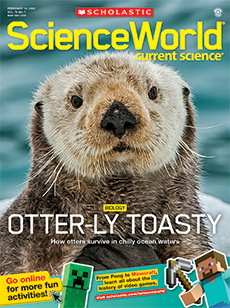Seeing a herd of mammoths roaming close to a town today would be a surprising sight. That’s because the massive animals haven’t existed on Earth for about 10,000 years! Mammoths lived during the ice age when sheets of ice covered most of what is now Europe, Asia, and North America. Beyond this frozen expanse stretched the tundra, a dry and cold region of grasslands that bison, horses, reindeer, and mammoths called home. Even though mammoths haven’t roamed the tundra for thousands of years, a U.S.-based company wants to “de-extinct,” or bring back, the animals and reintroduce them into the wild.
Colossal Biosciences plans to create a hybrid animal—a combination of a woolly mammoth and its closest living relative, the Asian elephant. Reviving the mammoth would provide a glimpse of a real-life prehistoric creature, says Ben Lamm, the co-founder of Colossal. “People have a childlike wonder to see what used to be here,” he says. Lamm believes that bringing back mammoths and other extinct animals could also benefit the planet (see Making a Comeback). He thinks their return may improve the health of their former ecosystems—communities of organisms interacting with their nonliving environments.
But some scientists aren’t so sure the company’s efforts will be successful—or if they should even try creating a mammoth hybrid. Critics say it’s hard to know if these animals would be able to survive in our modern world and whether they could cause more harm than good.
Earth looked very different 22,000 years ago. The last ice age was at its peak. Sheets of ice covered most of what is now Europe, Asia, and North America. Beyond the vast ice sheets, the tundra stretched out. It was a dry and cold region of grasslands. Bison, horses, reindeer, and woolly mammoths roamed it.
Mammoths looked similar to modern-day elephants. But they had long, curved tusks and a thick coat of shaggy hair. The environment got warmer, and early humans overhunted mammoths. So the animals died out about 10,000 years ago. Now a U.S.-based company wants to “de-extinct” mammoths. The company hopes to bring them back and return them to the wild.
Colossal Biosciences plans to create a hybrid animal. It would be part woolly mammoth and part Asian elephant. That’s the mammoth’s closest living relative. If the mammoth returns, people could see a real-life prehistoric creature, says Ben Lamm. He’s the cofounder of Colossal. “People have a childlike wonder to see what used to be here,” he says. And Lamm believes the planet could benefit from the return of mammoths and other extinct animals (see Making a Comeback). He thinks the animals may improve the health of their former ecosystems. These are communities of organisms in their environments.
But some scientists aren’t so sure the company will succeed. And they don’t know if a hybrid mammoth is a good idea. Critics say it’s hard to know what would happen. Could these animals survive in our modern world? And would they cause more harm than good?

